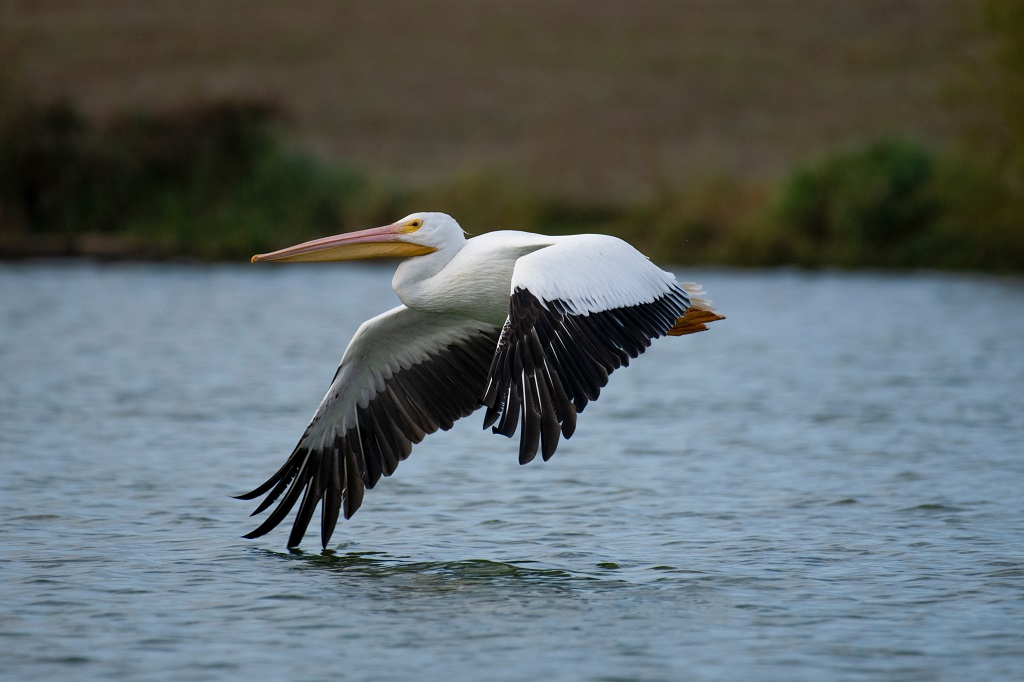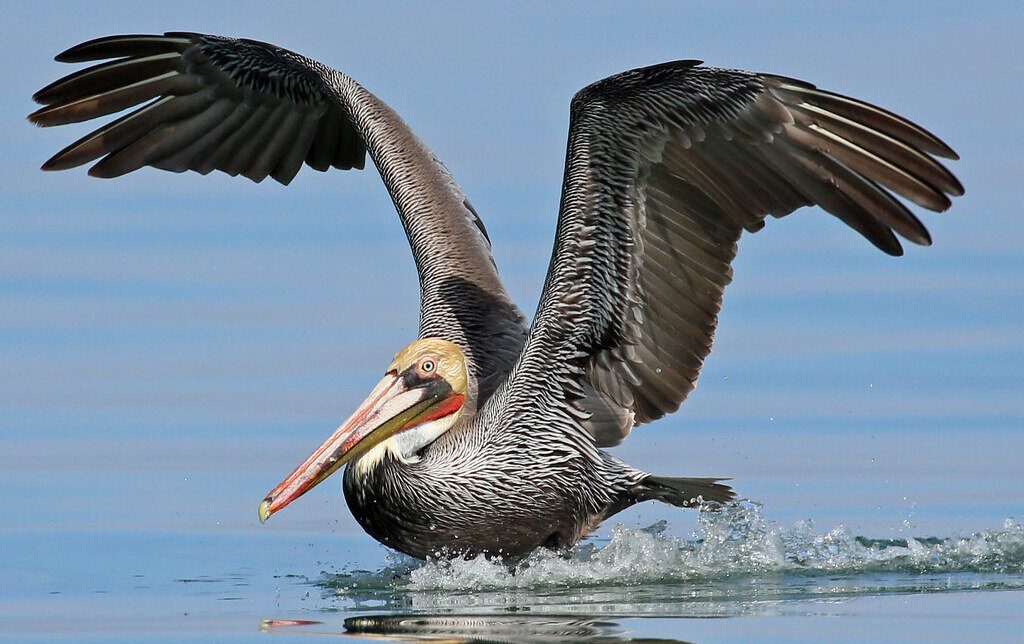Pennsylvania is home to two distinct species of Pelicans that can be found in North America. These species are the American White Pelican and the Brown Pelican.
During the summer months, it is possible to spot American White Pelicans in Pennsylvania, although they are not very common in the area. On the other hand, the presence of Brown Pelicans in Pennsylvania is rare or accidental, and they are seldom seen.
Pelicans are renowned for being among the largest birds worldwide and are easily recognizable due to their enormous bills, throat pouches, and feet. Despite their size, they are surprisingly lightweight, thanks to air pockets within their skeletal structure and skin, enabling them to float effortlessly. Additionally, their long wings aid in graceful soaring during flight.
The global population of pelicans consists of eight distinct species, two of which reside in North America: the American White Pelican and the Brown Pelican.
During the breeding season, pelicans undergo notable changes in their facial skin, throats, and bills, resulting in brighter and more vibrant colors. Some even develop additional structures on their bills.
Pelicans typically form breeding colonies comprising up to 50,000 birds. Depending on the species, they may choose either ground-nesting or tree-nesting habits. After spending approximately 25 days in the nest, the young pelicans congregate in groups called “creches,” where up to 100 fledglings gather. Interestingly, parents can recognize their own chicks and provide nourishment solely to their offspring.
While pelicans do prey on other animals, they are not classified as birds of prey, as that category exclusively includes raptors. The primary diet of pelicans consists of fish, although they also consume crabs, frogs, snakes, small mammals, birds, and insects.
Pelicans utilize their throat pouches to capture fish, subsequently draining the water before swallowing their prey. Young pelicans even feed directly from their parents’ pouches.
To aid in identifying the various pelican species spotted in Pennsylvania, this guide draws information from avibase and incorporates data collected by birdwatchers on ebird, offering genuine insights into when these magnificent birds can be observed.
Pennsylvania is home to two distinct pelican species:
American White Pelican

Although American White Pelicans are not commonly found in Pennsylvania, there have been occasional sightings during the summer season. A recent sighting occurred near Williamsport Dam in 2022.
These magnificent birds possess impressive wingspans, ranking as the second-largest among all North American bird species.
Adult American White Pelicans not in breeding plumage exhibit an overall white appearance, with black flight feathers visible during flight or when wings are spread. They boast bluish-gray eyes and yellow facial skin surrounding their eyes. Their bills, pouches, and feet are pale orange. Juveniles have light gray feathers with darker brown napes.
Breeding adult American White Pelicans display distinct coloring, diverging from their non-breeding counterparts. They develop a yellow plate on their upper bills, resembling a horn. Although their bodies remain predominantly white, their eyes, bills, legs, and feet assume brighter orange hues.
American White Pelicans undergo molting changes referred to as “eclipse.” In spring, a visible yellowish patch emerges on their breast and chest. During summer, blackish feathers appear on their heads.
- Pelecanus erythrorhynchos
- Length: 60 – 63 inches (152 – 160 cm)
- Weight: 246.4 ounces (6983 g)
- Wingspan: 96 – 110 inches (244 – 279 cm)
American White Pelicans breed in remote inland lakes across North America before migrating to spend the winter along the southern Pacific Coast of the United States, the Gulf of Mexico, Mexico, and Central America. During migration, they can be observed in various states in the western and central regions of the United States.
American White Pelicans can be found in shallow freshwater lakes, wetlands, and the perimeters of lakes and rivers. In the winter, they seek coastal bays, inlets, and estuaries, where they forage in shallow waters and rest on sandbars.
Their diet primarily consists of fish. They swim near the water’s surface, employing their massive bills to capture prey. Additionally, they engage in coordinated foraging efforts with other birds, efficiently driving fish toward the shore for easier capture.
As opportunistic feeders, American White Pelicans venture to different locations in search of abundant food sources. They may also consume crayfish, amphibians, and salamanders. Interestingly, they are known to pilfer fish from the water’s surface, snatching meals from other birds.
American White Pelican calls: Generally, these birds remain silent, emitting only occasional grunts. However, their young can be quite vocal in large colonies, vocalizing to demand food.
The nests of American White Pelicans are simple, shallow depressions on the ground. Twigs, sticks, reeds, and various materials are added atop the soil to provide protection for the eggs.
The female pelican then lays one to two eggs, which both parents incubate together for approximately thirty-six days. Unfortunately, only one chick survives in each nest due to siblicide, wherein one sibling eliminates the other.
Fun Facts: The impressive bill of the American White Pelican can hold up to three gallons of water. When scooping up fish, they tilt their bills downward to drain the water, subsequently swallowing the remaining fish inside their throat sac.
Brown Pelican

The presence of Brown Pelicans in Pennsylvania is considered rare or accidental, but there have been a few sightings. The most recent sighting occurred around Philadelphia in 2021.
Non-breeding adult Brown Pelicans typically exhibit white heads and necks with pale yellow foreheads. Their elongated bills feature a combination of yellow and orange hues. Their bodies display a grayish-brown coloration, complemented by short black legs and webbed feet. Juveniles possess brown heads, necks, backs, and wings, with bluish-gray bills. Their undersides are light brown.
The Brown Pelican encompasses five subspecies, with two breeding in the United States. P.o.californicus represents the variant found along the Pacific Coast, while P.o.carolinensis inhabits the Atlantic Coast.
During the breeding season, the differences between the Pacific and Atlantic Brown Pelicans become more pronounced. Both species exhibit white heads with vibrant yellow foreheads. However, their napes undergo a transformation from white to dark brown. Atlantic Brown Pelicans possess olive-brown throat pouches, while their Pacific counterparts exhibit red skin on their throat pouches.
- Pelecanus occidentalis
- Length: 48 – 50 inches (122 – 127 cm)
- Weight: 131.2 ounces (3718 g)
- Wingspan: 78 – 84 inches (198 – 213 cm)
Brown Pelicans either breed and migrate or remain resident year-round along the Pacific and Atlantic Coasts of North America, extending to northern South America.
These pelicans primarily inhabit shallow water environments. They can be found year-round in estuaries and coastal marine habitats. When resting, they frequent mangrove islets, sandbars, breakwaters, and offshore rocks.
Brown Pelicans possess a unique foraging ability that sets them apart. They are capable of diving into deep ocean waters to capture prey in their throat pouches. Upon resurfacing, water drains from their pouches, allowing them to promptly swallow their catch.
Their diet mainly consists of fish such as sardines and herring. When not diving, they casually swim and seize prey with their bills. They may also consume crustaceans, amphibians, eggs, and young birds.
Brown Pelican calls: Adult individuals are generally quiet, emitting occasional grunts. However, juveniles vocalize loudly to beg for food.
Nests of Brown Pelicans are often constructed on the ground rather than in trees. They typically seek concealed and protected locations on islands, mangroves, or cliffs. The female builds the nest using reeds, leaves, pebbles, sticks, and compacted soil. She lays two to four eggs, which both parents incubate for about a month.
Fun Fact: Brown Pelicans incubate their eggs by covering them with their webbed feet. This practice, while unique, posed a threat to the species when the pesticide DDT led to thinning of the eggshells, causing them to break under the weight of the parent’s feet. Numerous conservation efforts were necessary to restore the Brown Pelican population.